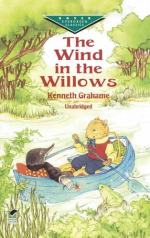|
This section contains 4,227 words (approx. 15 pages at 300 words per page) |

|
SOURCE: "Kenneth Grahame's The Wind in the Willows: A Companionable Vitality," in Touchstones: Reflections on the Best in Children's Literature, Vol. 1, Children's Literature Association, 1985, pp. 96-105.
In the following essay, Philip provides reasons why The Wind in the Willows remains a favorite book of both children and adults.
"Vitality—that is the test," wrote Kenneth Grahame, in his introduction to Aesop: A Hundred Fables (1899). It is a test The Wind in the Willows passes, for Grahame's best-known book possesses in abundance that quality by which Ezra Pound defined the true classic: "a certain eternal and irrepressible freshness." A. A. Milne called it a "Household Book": one to be kept constantly at hand, referred to, quoted, read aloud.
But it is also, it must be admitted, a very strange book. Early reviewers were entirely flummoxed by it, expecting another wickedly exact portrait of childhood in the mode of Grahame's...
|
This section contains 4,227 words (approx. 15 pages at 300 words per page) |

|


